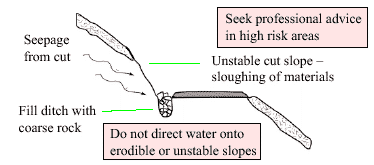| Forest Road Drainage Installation Practices | |
| in the Pacific Northwest | |
| 12 - Ditch Management | Vegetation, Ditch Erosion, Ditch Shape |
Ditches have the function to catch seepages and intercepted underground flows, and to take their water through cross-drain culverts to the low side of the road, keeping the roadbed well drained. If possible, ditch drains should not discharge directly into streams.
|
On grades steeper than 5%, ditch vegetation should be encouraged as a means to prevent ditch erosion, especially in fine-textured soils. If trees and shrubby vegetation in the ditch obstruct visibility or become a safety hazard, ditch maintenance strategies should favour brush cutting over ditch excavation. Digging materials from the ditch may create oversteepened ditch slopes, removes the vegetation root mass and may renew sediment transport.
Ditch erosion occurs when water is carried down ditches for long distances, especially on steep grades. In extreme cases, ditch erosion can destabilize stable cut slopes. Install frequent cross drains to reduce the amount of water and its energy. In fine-textured soils where fill slopes are highly erodible, cross drain culverts, flumes and halfpipes are not desirable, even with erosion protection, because of the inherent risk of erosion. An alternative is to armour the ditch with rock and carry water down grade in the ditch until it can be safely taken across with a cross drain culvert. Placing "rock steps" in the armoured ditch at right angle to the flow will also collect fines and slow down the ditch water. Narrow, V-shaped ditches will speed up flows, whereas wide, flat-bottom ditches will slow it down. This is important to know because doubling the water velocity (speed) will allow the water to move particles 32 times bigger and 64 times heavier. Remember the sediment triangle.
A number of manufactured products such as silt fences, silt grids etc., are available to reduce ditch erosion and to collect fines. However, they should be considered temporary solutions that require regular inspections, maintenance, and eventual replacement. Remember that the best ditch will fail if sloughing of the cut slope occurs. Ditch construction and maintenance should therefore always establish stable cut slope angles. Where the road cut is constantly sloughing and filling the ditch, a longitudinal french drain can be used. Insloping or outsloping the road surface may also be appropriate to control water flows. Do not direct water onto erodible or unstable slopes.

| 12 - Ditch Management |
| Next |
||
| PLANNING ISSUES |
INSTALLATION PRACTICES
|
|
©1999 - 2001 Flip Productions Limited Used with permission by CulvertBC |